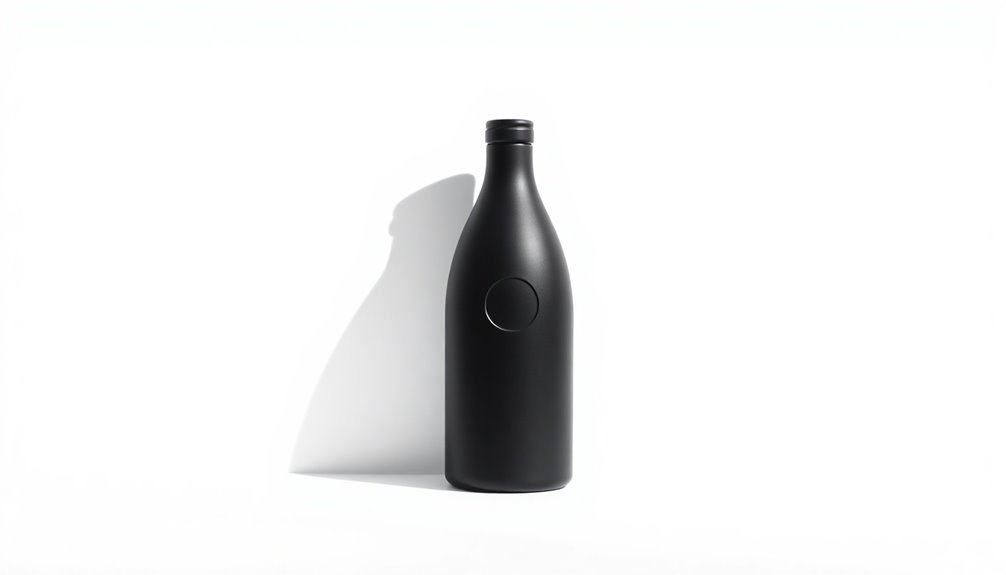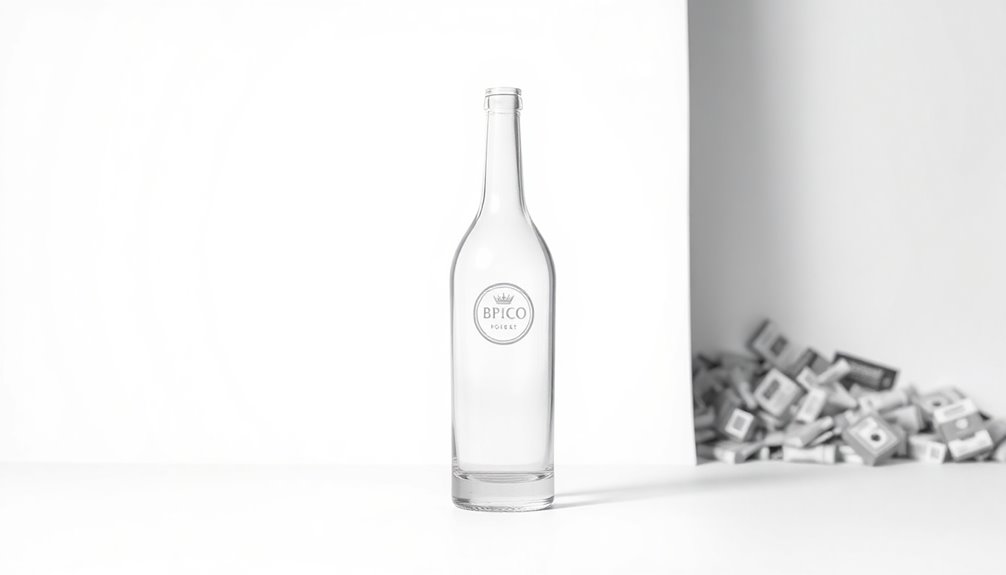Many people overlook how minimalist branding can profoundly impact consumer choices. It's not just about stripping away excess; it's about creating a clear identity that resonates. Brands like Apple and Nike show us that simplicity can forge deeper emotional connections. But what exactly do they do that makes their approach so effective? Understanding these strategies could change how you perceive branding and its influence on your purchasing decisions.
Key Takeaways
- Top brands like Apple and Nike leverage clean designs to enhance recognition and convey premium quality through minimalist branding.
- Limited color palettes and bold typography create striking visual impact, ensuring clarity and effective communication with consumers.
- Minimalist branding reduces cognitive overload, fostering emotional connections and increasing brand loyalty among consumers.
- Successful brands maintain simplicity while integrating unique characteristics, balancing visual appeal with brand identity.
- Future trends in minimalist branding may include personalized designs, broader color palettes, and immersive experiences without sacrificing simplicity.
The Essence of Minimalist Branding

When you think about minimalist branding, it's all about clarity and simplicity. This approach uses clean design and limited visual elements to create a powerful brand identity.
Brands like Apple and Nike demonstrate how simplicity can enhance brand recognition by quickly capturing attention. The effectiveness of minimalist branding is evident, as research shows that companies with straightforward branding can outperform competitors by 214%.
Simplicity in branding, as seen with Apple and Nike, significantly boosts recognition and can lead to remarkable competitive advantages.
By employing minimal design and a restricted color palette, brands achieve visual harmony that highlights essential elements. The psychological principle of cognitive ease indicates that simple visuals are processed faster, leading to better retention and emotional connections with consumers. Additionally, networking seen as essential for expanding brand reach can further amplify the impact of minimalist branding.
Ultimately, embracing minimalist branding can transform your brand into something memorable and impactful.
Key Principles of Minimalism in Design

Minimalism in design hinges on the principle that "less is more," allowing you to focus on essential elements while eliminating the clutter. This approach serves as a powerful tool for establishing visual identity through simplicity in branding.
By utilizing negative space effectively, you draw attention to key brand elements, creating harmony and reinforcing your message. Limited color palettes, often showcasing monochrome or dual-tone schemes, contribute to an uncluttered design that enhances brand recognition across platforms.
Additionally, bold typography, typically sans-serif, guarantees clarity and legibility, making your messages memorable. Brands like Apple and Nike exemplify how minimalist design can create impactful identities, proving that simplicity is a crucial ingredient for success in today's competitive landscape. A distinctive decor style can also enhance overall aesthetic appeal, reflecting the importance of unique spaces that resonate with individual tastes and preferences.
The Psychological Impact of Simplicity

Simplicity in branding plays an essential role in shaping consumer perceptions and behaviors. Minimalist branding leverages cognitive ease, allowing you to process visuals faster, which enhances retention and recall.
By presenting fewer choices, brands reduce decision fatigue, making it easier for you to make purchasing decisions. This streamlined approach fosters emotional resonance, evoking feelings of calm and trust that strengthen your connection to the brand.
Fewer choices alleviate decision fatigue, fostering trust and emotional connection with the brand.
Additionally, the scarcity principle boosts perceived value, increasing consumer demand and driving engagement. Research shows that clear, simple messaging resonates more effectively, translating into brand loyalty and satisfaction.
Ultimately, the psychological impact of simplicity not only influences your choices but also cultivates lasting relationships with brands you trust. Moreover, incorporating mindfulness techniques into branding strategies can enhance present-moment awareness and deepen consumer engagement.
Successful Brands Embracing Minimalism

When you think of successful brands embracing minimalism, Apple and Uniqlo stand out.
Apple's clean aesthetic not only simplifies user experience but also reinforces its identity as a premium brand.
Similarly, Uniqlo's practical branding makes it easy for consumers to connect with their products, reflecting a modern preference for clarity and functionality. Moreover, the focus on continuous learning and adaptation allows these brands to evolve while maintaining their minimalist approach.
Apple's Clean Aesthetic
Apple's clean aesthetic stands out as a hallmark of modern branding, enchanting consumers with its elegant simplicity. By utilizing minimalist design elements, Apple crafts a sophisticated brand identity that resonates with modern consumers.
Their product packaging often features ample whitespace and a limited color palette, drawing attention to the product itself while enhancing user experience. The iconic logo reflects this clean aesthetic, becoming a globally recognized symbol of quality and innovation.
Furthermore, Apple's commitment to simplicity extends to its user interface, ensuring intuitive navigation that feels clutter-free. This consistent application of minimalist principles not only elevates their products but also fosters strong customer loyalty, as users perceive a higher quality in everything Apple offers. Additionally, Apple's focus on personalized learning experiences helps ensure that their technology is accessible and effective for all users.
Uniqlo's Practical Branding
Uniqlo's branding strategy embraces minimalism in a way that resonates with today's consumers, focusing on practicality and functionality.
You'll notice their simple designs prioritize comfort and versatility, making it easy to find everyday clothing. Uniqlo's use of minimal text and straightforward descriptions helps you quickly grasp product offerings, supporting informed decisions.
The brand employs a limited color palette, often neutral tones, to create a cohesive and recognizable visual identity across marketing and retail spaces.
Their uncluttered design extends to store layouts, featuring clean lines and ample whitespace that enhance your shopping experience and highlight key products. Additionally, the brand's approach echoes the concept of high vibrational energy, which is essential in creating positive consumer experiences.
The Role of Color and Typography

When you think about minimalist branding, color choices and typography play an essential role in shaping your brand's identity.
A limited color palette can create a striking visual impact, while bold typography enhances clarity and guarantees your message resonates.
Together, they not only make your brand memorable but also reflect professionalism and trust. Additionally, maintaining content relevance is crucial as it ensures that your brand's visual elements align with the expectations and needs of your target audience.
Impact of Color Choices
In minimalist branding, the impact of color choices and typography can't be overstated. Thoughtful color choices create limited color palettes, often employing monochrome or dual-tone schemes that enhance brand recognition.
The strategic use of color evokes specific emotions; for instance, blues can instill calmness while reds spark excitement. This psychological impact is vital in connecting with consumers.
Bold typography, especially sans-serif fonts, guarantees clarity and legibility, allowing for effective communication in a cluttered market. By carefully selecting color contrasts, you can highlight key elements, making sure essential information captures attention.
Research shows that color can boost brand recognition by up to 80%, emphasizing the importance of these choices in minimalist branding strategies. Additionally, essential oils in aromatherapy can also benefit from similar principles of simplicity in design to effectively convey their calming properties.
Typography's Role in Clarity
Color choices set the stage for minimalist branding, but typography takes center stage in guaranteeing clarity. Effective typography employs bold, sans-serif fonts that enhance legibility, making key messages pop. By limiting font styles, you foster consistency across all materials, boosting brand recognition. Monochromatic or dual-tone schemes create visual harmony, guiding the viewer's eye to essential content. Research shows that clean typography is linked to higher quality and trustworthiness in brands, reducing cognitive load and enabling quicker information processing. Additionally, similar to how natural materials are emphasized in farmhouse design, the choice of typography can greatly affect the overall aesthetic and feel of a brand.
| Aspect | Importance | Example |
|---|---|---|
| Typography | Enhances clarity | Bold sans-serif |
| Legibility | Guarantees easy reading | Simple fonts |
| Consistency | Builds brand recognition | Limited styles |
| Monochromatic | Visual harmony | Black on white |
| Trustworthiness | Influences perceptions | Clean design |
Benefits of Minimalism in Consumer Perception

Minimalism in branding offers several key benefits that greatly shape consumer perception. By adopting a minimalist brand identity, you make it easier for consumers to understand your message.
Clean designs and recognizable logos contribute to a sense of reliability and higher quality, allowing your brand to remain relevant in a crowded market. Embracing simplicity fosters deeper emotional connections, enhancing your brand's core values and resonating with your audience.
Research shows that brands utilizing minimalist strategies see significant boosts in customer recognition and loyalty, outperforming competitors in brand recall. By creating a brand with limited color palettes and straightforward visuals, you simplify decision-making, reducing cognitive overload for consumers and increasing their engagement with your brand. Furthermore, brands that emphasize emotional alignment with goals often create stronger bonds with their audience, enhancing overall customer satisfaction.
Balancing Simplicity With Brand Identity

While aiming for a minimalist approach in branding, it's crucial to guarantee that simplicity doesn't overshadow your brand's identity. Effective branding blends simplicity with recognizable elements that reflect your brand personality.
A minimalist branding approach must preserve brand identity, merging simplicity with recognizable elements that embody your personality.
Here are some key strategies to maintain that balance:
- Focus on core messages that resonate with your audience.
- Retain unique characteristics to reinforce consumer trust.
- Integrate vital features thoughtfully into your designs.
- Guarantee visual appeal without compromising brand essence.
Brands like Apple and Nike illustrate how minimalism can enhance brand identity while remaining distinct.
Common Pitfalls of Over-Simplification

As you navigate the world of branding, it's essential to be aware of the common pitfalls that come with over-simplification. Stripping away unique brand characteristics can make your identity blend into a crowded marketplace, reducing brand recognition.
For instance, the backlash against Gap's 2010 logo change highlights how neglecting consumer feedback can damage customer loyalty. Similarly, Jaguar's 2024 rebranding effort lost its iconic elements, proving that simplicity should enhance, not dilute, brand identity.
Achieving a balance between simplicity and your brand's essence is important; over-simplified designs can seem unrefined and fail to resonate with your target audience.
Stay attuned to feedback, ensuring your branding reflects both clarity and the unique qualities that set you apart.
The Future of Minimalist Branding Trends

With the rise of consumer expectations and technological advancements, the future of minimalist branding is set to evolve in exciting ways.
The future of minimalist branding promises to adapt and thrive amidst evolving consumer expectations and technological innovations.
As brands adapt, you'll notice several key trends emerging:
- Incorporating broader color palettes and background textures while maintaining simplicity.
- Leveraging augmented reality (AR) and virtual reality (VR) for immersive experiences.
- Focusing on sustainability and ethical practices that resonate with environmentally conscious consumers.
- Utilizing personalized designs that cater to individual needs while keeping a clean aesthetic.
These shifts will allow brands to engage with dynamic content, aligning with changing consumer preferences.
Frequently Asked Questions
Why Is Simplicity Important in Branding?
Simplicity's essential in branding because it enhances clarity and makes your message easier to grasp.
In a world filled with distractions, you want your audience to connect quickly with your brand. Simple designs and messaging reduce decision fatigue, helping consumers feel less overwhelmed.
When you focus on straightforward communication, you build trust and authenticity, making it more likely that potential customers will engage with you and remember your brand.
Is Minimalism and Simplicity the Same Thing?
No, minimalism and simplicity aren't the same thing.
While minimalism focuses on reducing design elements to their essentials, simplicity emphasizes clarity and straightforwardness in communication.
You'll find that minimalism often uses a limited color palette and fewer elements, whereas simplicity can incorporate more variety as long as the message is clear.
Understanding these distinctions helps you appreciate how each approach can enhance branding and improve user experience effectively.
Why Is Minimalism Important in Branding?
Minimalism's essential in branding because it helps you quickly convey your message and values.
In a world where attention spans are short, simple designs grab attention and create lasting impressions.
By reducing clutter, you enable customers to focus on what matters, improving their trust and perception of your brand.
Plus, fewer options mean less decision fatigue for your audience, making it easier for them to connect with your offerings and remember your brand.
Why Is Minimalist Brand so Popular?
Think of minimalist branding like a refreshing change in a stuffy room.
It's popular because it cuts through the noise, making choices easier for you. With clean designs and straightforward messages, brands create a sense of clarity and trust.
You appreciate the elegance and sophistication, which aligns with your desire for simplicity in a complex world.
This approach resonates with your values, fostering loyalty and deeper connections with the brands you love.
Conclusion
In a world saturated with noise, minimalist branding proves that simplicity isn't just an aesthetic choice; it's a strategic advantage. By stripping away the unnecessary, brands like Apple and Nike connect more deeply with consumers. However, there's a fine line between simplicity and oversimplification. If a brand loses its essence in the quest for minimalism, it risks alienating its audience. Ultimately, striking the right balance is key to maintaining identity while fostering a powerful, recognizable brand presence.









